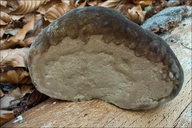|
|
click photo for larger file

Phellinus igniarius
Willow Bracket Fungus
|
Photographer: Dr. Amadej Trnkoczy
ID: 0000 0000 0217 2227 (2017-02-20)Copyright © 2017 Dr. Amadej Trnkoczy
|
|
INFORMATION PROVIDED WITH THE PHOTO
|
date of photo Nov 27, 2011
latitude 46.33194 longitude 13.58357
View on Google Maps.
location
Bovec basin, right bank of river Soča near Jablenca settlement, East Julian Alps (Posočje, Slovenia)notes Slo.: vrbov putač - syn.: Ochroporus cinereus (Niemelä) Fischer, Phellinus alni (Bondartsev) Parmasto, Ochroporus ossatus Fischer, Fomes igniarius (Fr.ex.L.) Gillet - Habitat: Soča river shore, mixed forest (Pinus sp. and Picea abies dominant), south oriented slope, calcareous ground (conglomerate), humid air, sunny and relatively warm place, exposed to direct rain, average precipitations ~ 3.000 mm/year, average temperature 8-10 deg C, elevation 400 m (1.300 feet), alpine phytogeographical region. Substratum: fallen trunk of Fagus sylvatica in its initial stage of disintegration and massively infected also with Schizophyllum commune and Hypoxylon fragiforme. Comments: Phellinus igniarius (group) is without doubt the most difficult 'species' for determination of all members of genus Phellinus (Ref.3 and 4). It is extremely variable morphologically, but also microscopically traits are variable and barely sufficient to separate several taxa of this group (P. cinereus, P. igniarius s.str., P. alni). Several authors do not recognize fully these taxa. Antioxidative and anti-cancer effects of Phellinus igniarius extracts have been observed.. There is no microscopy for this find; hence the determination is uncertain. However, young sporocarps of Phellinus igniarius often have roundish shape with rounded inflated pileus margin like this find. Dark (reddish) brown, woody and concentrically layered trama, pores and pileus surface and color correspond reasonably well to Phellinus igniarius, or, at least, this is the best fit I was able to find. Regarding substratum Salix is the most common for this species, but it has been found also on many other broadleaved trees. However, Fagus sylvatica is not mentioned in the literature available to me. This sheds some additional doubts in this determination. Growing solitary. 5% KOH on trama, pileus surface and pore surface dark-brown to almost back reaction. Pileus was woody/cocky, but not very hard to cut. (still young?). Ref.: (1) L. Ryvarden, I. Melo, Poroid fungi of Europe, Synopsis Fungorum 31., Fungiflora (2014), p 321. (2) J. Breitenbach, F. Kraenzlin, Eds., Fungi of Switzerland, Vol.2. Verlag Mykologia (1986), p 260. (3) G.J. Krieglsteiner (Hrsg.), Die Grosspilze Baden-Württembergs, Band 1., Ulmer (2000), p 455. (4) A. Bernicchia, Polyporaceae, s.l., Fungi Europaei, Vol. 10., Edizioni Candusso (2005), p 412.camera Canon G11, 6.1-30mm/f2.8-4.5
contributor's ID # Bot_578/2011_IMG7851 photo category: Fungi - fungi
|
MORE INFORMATION ABOUT THIS FUNGUS
|
| common names
Willow Bracket Fungus (photographer)
View all photos in CalPhotos of Phellinus igniarius Check Google Images for Phellinus igniarius |
|
The photographer's identification Phellinus igniarius has not been reviewed. Click here to review or comment on the identification. |
|
Using this photo The thumbnail photo (128x192 pixels) on this page may be freely used for personal or academic purposes without prior permission under the Fair Use provisions of US copyright law as long as the photo is clearly credited with © 2017 Dr. Amadej Trnkoczy.
For other uses, or if you have questions, contact Dr. Amadej Trnkoczy amadej.trnkoczy[AT]siol.net. (Replace the [AT] with the @ symbol before sending an email.) |
|
|
